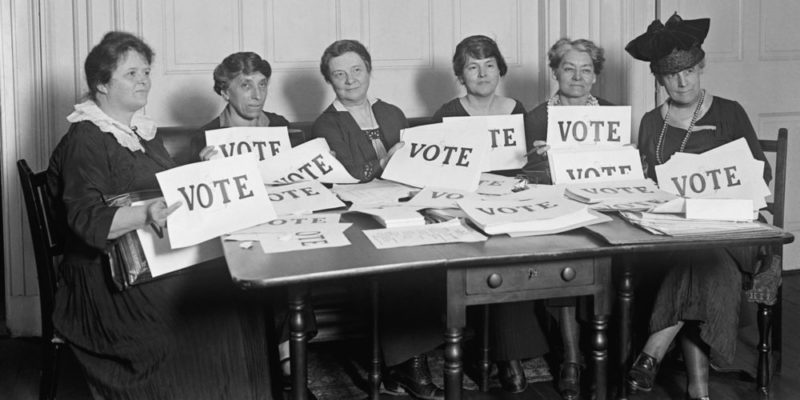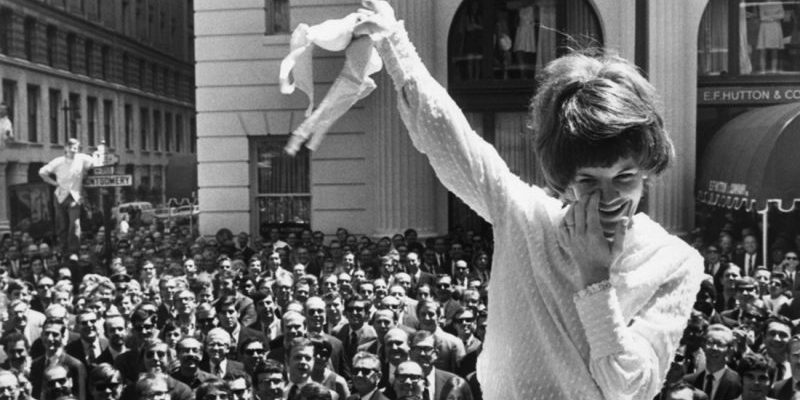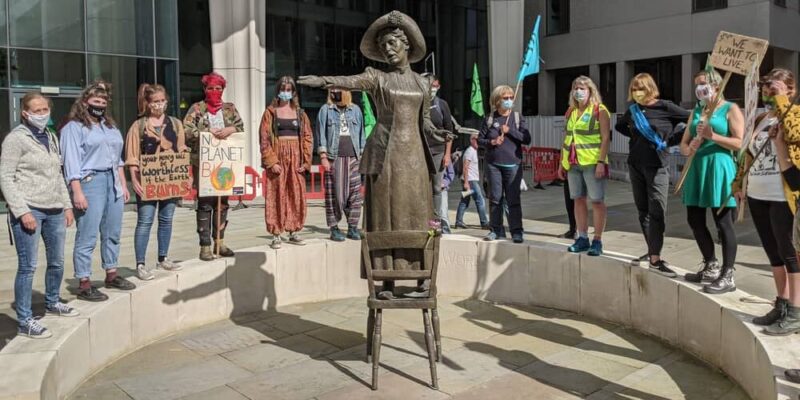We explain what feminism is when it emerged and what its characteristics are. In addition, its evolution, the role of man, and more.
What is the feminist movement?
The feminist movement is the fight for an essential democratic principle that is equal rights between women and men . Feminism is not the opposite of machismo, which prioritizes the rights of a single gender, but rather seeks to achieve equality.
Feminism calls for the liberation of women and the elimination of hierarchies and privileges imposed by men on men under a patriarchal system that has long been perpetuated through cultural structures.
It is an international movement that has been fighting for centuries for the recognition of women. The last 30 years are considered the fourth wave of the movement. However, throughout the world there continue to exist various realities of injustice and rejection that do not respect the equal rights of all beings.
It is estimated that another 200 years will have to pass before women achieve democratic equality, considerably reduce gender violence and achieve equal opportunities and economic participation.
Origin of the feminist movement

The origin of the feminist movement dates back to the 18th century at the time of the Enlightenment in which the bourgeoisie fought against the absolutism of the nobility. It was an influential historical period for Western culture in which science and democracy gained prominence , over the Church and the monarchical government system .
In the French Revolution of 1789, women were protagonists along with men in a revolutionary movement against monarchical absolutism and in defense of rights and freedoms. However, after the declaration of the Rights of man and citizen , women were excluded from political and civil rights .
The deprivation of women's rights had been lived for centuries and was due to the oppression of patriarchal systems (in which the authority of men predominates) that exercised various methods of slavery and subjection to people of different races. , the humble lower class and women, among other groups.
The French writer, playwright and philosopher Marie Gouze (1748 – 1793), who used the pseudonym Olympe de Gouges, wrote feminist and revolutionary texts against slavery in all its forms. She defended equality between women and men and rights such as the right to education , to vote, to public work and equal roles in family intimacy. However, she was sentenced to death for her ideas.
In 1848, the first women's rights convention was held in the city of Seneca Falls, United States, which culminated in the Seneca Falls Declaration, the first collective document of feminism that established the claim for social, civil rights , political and religious women. It was a key event for the feminist movement.
However, starting in the 19th century, women's claims were formalized through demonstrations, such as the one in 1913 in New York, United States, in which women claimed the right to vote and be elected to public office.
In 1948, the United Nations Organization approved the Universal Declaration of Human Rights, which included in article number 21 the right of everyone to participate in the government of their country and to express themselves through suffrage.
Milestones of feminism
Among the main milestones of the feminist movement are:
- The first women reported to have rebelled against oppressive culture between the 15th and 17th centuries were Christine de Pizan, Marie de Gournay, and Mary Astell.
- The French Revolution of 1789 meant, for the first time, the union of women for the claim of their rights. Although they fought together with men against monarchical absolutism, a general awakening of women was provoked by the demand for equal rights.
- In 1791 the revolutionary writer and activist Olympe de Gouges produced an essay that turned out to be the first declaration of women's rights , including freedom , equality and political rights to vote , but was rejected by patriarchal leaders.
- At the end of the 18th century, women who demanded equal rights or met in clubs to propose political improvements were silenced or annihilated by men in positions of power.
- Mary Wollstonecraft rebelled against arguments about the inferiority of women given by men such as Jean-Jacques Rousseau who said that women should be weak and passive, and that they were made to please men.
- The inequality of rights between women and men was not biological, but was the product of education and social patterns established by men.
- In the demonstrations of the feminist movement , the right of access to education was demanded because it was key for women to achieve autonomy and economic independence.
- The idea that both men and women have the same capacities to feel, think and reason was defended.
- In 1848, the first collective document of feminism called the Seneca Falls Declaration was made, a name that alludes to the city in the United States in which it took shape.
- After the civil war in the United States, called the Civil War, between 1861 and 1865, freed slaves were allowed to vote, but not women .
- In 1903 the leader of the British suffragist feminists Emmeline Pankhurst founded the Women's Social and Political Union and harangued other women to claim their right to equality. Many of those women were imprisoned.
- March 8, 1909 was the first time that International Women's Day was commemorated in New York, United States, to recognize the struggle of women for their rights.
- During the First World War in 1914 British women replaced men in their jobs because they had to march to the front of the war. Aware of their abilities, women intensified their demand for access to the female vote.
- In 1920 in the United States, the right of women's suffrage was included in the modification of the North American constitution.
- In 1928 the British constitution was modified and women could exercise the vote on equal terms with men.
- At the beginning of the 20th century, the second wave of the feminist movement took place. Starting in 1960, with the influence of the British writer Virginia Woolf who lived her sexuality with absolute freedom and publicly stated that she was bisexual, more feminist claims were generated.
- The way women dressed was one of the conventions of ancient times, which oppressed them with corsets and uncomfortable dresses. Part of the revolution advanced through fashion .
- French designer Coco Chanel created clothes that contributed to women's liberation , adapting men's clothing to the female body. He made comfortable clothing and flat shoes to give greater freedom of movement.
The sexual revolution of the '60s

The sexual revolution of the 1960s marked a before and after in history and further promoted the women's liberation movement . It was a social movement initiated by young people who defended the concept of freedom for men and women that manifested itself through sexuality, an aspect that had been prohibited until then and was hardly talked about.
The sexual revolutionary movement had its heyday in the 1970s and 1980s and became visible in all aspects of culture , such as music, film, art and literature, all over the world.
One of the main aspects of the revolution was that sexuality was disassociated from reproduction and understood from the point of view of pleasure . It was not considered as something prohibited or that it was only necessary for reproduction.
Some characteristics of the sexual revolution were:
- The display of bodies.
- The use of more comfortable, informal and colorful clothing.
- The men grew long hair and beards.
- Women stopped wearing heels and bra.
- The women wore miniskirts, oxford-style jeans and light dresses.
- The hippie movement was represented by young pacifists who fought against social injustice.
- The idea of free love that was opposed to the structures established by the Church and culture.
- The freedom to choose over their own bodies, to choose motherhood and to fight for gender freedom.
- The demand for the right to access contraceptive methods , such as the contraceptive pill and condoms.
- The idea that sexual pleasure also concerns women and not just men.
- The motto: “make love, not war”.
The woman turned out to be a consumer object molded based on stereotypes of beauty and supposed liberation, through which many men could enrich themselves economically.
Evolution of the feminist movement
In the eighteenth century, during the first wave of feminism, women's claims were based on the right to equality, access to public office and suffrage.Over the centuries, the movement continued its struggle and went through the so-called second and third waves of feminism in which more rights were claimed and more women, such as African Americans, and other genders were taken into account.
Among the main characteristics of the evolution of the feminist movement are:
- In 1949 the French Simone de Beauvoir published the essay The Second Sex that Shook France. It was considered a scandal and inappropriate, especially by religious sectors. However, it turned out to be one of the works that founded the second wave of feminism. A couple of decades later it was considered a bedside book by the women's liberation movement.
- Liberal feminism until the middle of the 20th century demanded reforms in the laws . However, the laws by themselves were not the ones that could change society because the root of the problem was even deeper with a deep-rooted social and political structure: the patriarchal system in which men exercised dominance over women.
- Starting in the 1970s, radical feminism focused its fight against the patriarchy that promoted its domination from the family sphere, a power relationship that later extended to the public sphere in which men had benefits over women. . The concepts of patriarchy, gender diversity and sexual harassment were established.
- At the end of the 20th century, between liberal and radical feminism, women achieved various revolutionary rights, such as divorce, legalization of abortion, defense against harassment and sexual violence, contraceptives, among others.
- At the beginning of the 21st century, the third wave of the feminist movement took into account hitherto ignored sectors , such as African-American women, Islamic women or transsexuals.
- In the 21st century, during the fourth wave of feminism, it is no longer considered a homogeneous movement , but there are different ways of carrying out the claim for the rights of feminism that transcend the biological sex of the individual and are based on the diversity of gender between people.
- Feminism established the slogan "not one less" to refer to demonstrations against violence and, the most serious and visible consequence, the murders of women at the hands of men. Years ago, society used to call these murders "crimes of passion" and today they are recognized as "femicides", a term that refers to gender-based murders that are one of the most extreme forms of violence. against women. For the most part, the ties that link the victims to the murderers are intimate relationships.
Main representatives of feminism
 Among the main representatives of the feminist movement throughout history, the following stand out:
Among the main representatives of the feminist movement throughout history, the following stand out:
- Betty Friedan (1921-2006). She was an American feminist theorist and leader who in the 1970s wrote The Feminine Mystique, an essay that addressed the oppression that existed at the time in the realm of family, marriage, and sexuality.
- Clara Campoamor (1888 – 1972). She was a Spanish lawyer, writer and politician. Her full name was Carmen Eulalia Campoamor Rodriguez and she was a defender of women's rights. She reached the position of deputy in 1931 and promoted the female vote in 1933.
- Christine de Pizan (1364 – 1430). She was a 15th century poet and writer who defended the idea that female inferiority was not something natural, but something cultural imposed by the repression of men. He insisted that women were limited by the prohibition to access education on equal terms with men. He wrote The City of Ladies .
- Arenal Conception (1820 – 1893). She was a Spanish legal expert, journalist, poet and playwright who defended the intellectual capacity of women and their right to receive the same education as men. Because college was still off-limits to women, Concepción attended criminal law classes dressed as a man.
- Elizabeth Cady Stanton (1815-1902). She was a pioneering American suffragette in the fight for women's rights. In 1848 he participated in a petition to Congress to recognize the right to private property and the free disposal of his assets. In 1848, together with Lucretia Mott, they gave the first national conference of feminism held in Seneca Falls, United States, which gave rise to the Seneca Falls Declaration.
- Emilia Pardo Bazan (1851 – 1921). She was a Spanish novelist, writer and journalist who was part of the nobility. She was a pioneer in defending the rights of women that she claimed throughout her literary work. One of his most popular novels was Los pazos de Ulloa from 1886.
- Emmeline Pankhurst (1885-1928). She was an influential British feminist leader who helped put into action the rights claim that English women had been making in a pacifist way. In 1903 she founded the Women's Social and Political Union.
- Mary Astell (1666-1731). She was an English philosopher and writer and one of the first feminists who fought for the right to equal opportunities in education for women. She came to the conclusion that men and women had the same capacity to reason and think, and she asked herself: If all men are born free, why are all women born slaves?
- Mary Wollstonecraft (1759-1797). She was a British philosopher who rebelled against the arguments made by some men about the "natural inferiority of women" that relegated them to second place. He argued that inequality was not biological, but was the result of education and the patterns established by men. She wrote an essay on the Vindication of the rights of women that was one of the first feminist works in history.
- Marie de Gournay (1565-1645). She was a French writer, poet and translator who stood out for being a precursor to feminism. In her work she analyzed and argued the causes of inequality and the various mechanisms of disavowal of women. In 1622 he wrote the work Equality of men and women .
- Marie Gouze (1748-1793) . Known by her pseudonym Olympe de Gouges, she was a French writer, playwright, and philosopher who drafted the Declaration of the Rights of Woman and the Female Citizen in 1791. She fought to abolish slavery in all its forms and was sentenced to death. death by guillotine
- Simone de Beauvoir (1908-1986). She was a writer who wrote the essay "The Second Sex", considered the best analysis of the situation of women, in which she delved into biological, psychological and anthropological issues, and was a pioneer of theories on gender differences. In addition, she is recognized by the phrase "You are not born a woman, you become one". Her partner was the philosopher Jean-Paul Sartre who said that Simone was the woman necessary for feminism.
- Susan Brownell Anthony (1908-1986). She was an American writer who stood out for her fight for women's rights and was influential in obtaining the female vote. In 1869, she founded the National Woman Suffrage Association with Elizabeth Cady Santon.
- Virginia Woolf (1882-1941). She was a British writer and novelist who stood out for her avant- garde modernist style and for representing feminism. His works reflected the narrative technique of the monologue and the poetic style that reflected on the condition of women.
The role of men in feminism
 The role of men in the feminist movement has to do with how they actively participate in the revolution. A man who participates in a feminist demonstration is usually seen as someone who claims from a place of privilege because he has never suffered oppression.
The role of men in the feminist movement has to do with how they actively participate in the revolution. A man who participates in a feminist demonstration is usually seen as someone who claims from a place of privilege because he has never suffered oppression.The individual change of the male is more revolutionary, instead of only participating in the demonstrations together with the women. Feminism is about the visibility of women and the need to respect their rights just as those of men are respected.
Men can and need to participate actively in the feminist movement, changing their own attitudes based on the patriarchal system and sexist customs, to change from their actions and their example the behavior of the men around them in society, such as friends, co-workers and recreational activities.
A good way for men to participate in the feminist movement is with concrete actions, such as taking care of their children so that women attend demonstrations, talking to their male friends about the problem and how invisible attitudes and mandates are macho, from jokes to respect for rights, among other ways.
The above content published at Collaborative Research Group is for informational and educational purposes only and has been developed by referring to reliable sources and recommendations from technology experts. We do not have any contact with official entities nor do we intend to replace the information that they emit.
Abubakr Conner brings a diverse skill set to our team, and covers everything from analysis to the culture of food and drink. He Believes: "Education is the most powerful weapon that exists to change the world." .
Leave a reply
Your email address will not be published. Required fields are marked *Recent post

Sport: What Is It, Types, Risks, Features, Characteristics and Examples

Dogs: Emergence, Features, Characteristics, Feeding and Breeds

Story: Definition, Elements, Structure, Features and Characteristics

